Remove the bed plate (A).
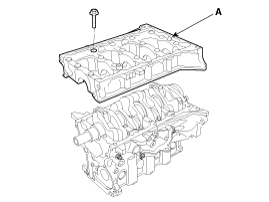
Engine removal is required for this procedure.
Use fender covers to avoid damaging painted surfaces.
To avoid damaging the cylinder head, wait until the engine coolant temperature drops below normal temperature before removing it.
When handling a metal gasket, take care not to fold the gasket or damage the contact surface of the gasket.
To avoid damage, unplug the wiring connectors carefully while holding the connector portion.
Mark all wiring and hoses to avoid misconnection.
Turn the crankshaft pulley so that the No.1 piston is at TDC (Top dead center).
Automatic transaxle : Remove the drive plate.
(Refer to Cylinder Block – “Drive Plate”)
Manual transaxle : Remove the flywheel.
(Refer to Cylinder Block – “Flywheel”)
Remove the rear oil seal.
(Refer to Cylinder Block – “Rear Oil Seal”)
Install the engine to engine stand for disassembly.
Remove the timing chain.
(Refer to Timing System – “Timing Chain”)
Remove the intake manifold.
(Refer to Intake And Exhaust System - "Intake Manifold")
Remove the exhaust manifold.
(Refer to Intake And Exhaust System - "Exhaust Manifold")
Remove the cylinder head.
(Refer to Cylinder Head Assembly - "Cylinder Head")
Remove the water pipe.
(Refer to Cooling System – “Water Pipe”)
Remove the bed plate (A).

Remove the connecting rod cap (A).
Mark the connecting rod caps to be able to reassemble in the original position and direction.

Remove the piston and connecting rod assemblies.
Using a ridge reamer, remove all the carbon from the top of the cylinder.
Push the piston, connecting rod assembly and upper bearing through the top of the cylinder block.
Keep the bearings, connecting rod and cap together.
Arrange the piston and connecting rod assemblies in the correct order.
Lift the crankshaft (A) out of the engine, being careful not to damage journals.
Arrange the main bearings and thrust bearings in the correct order.
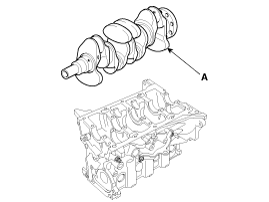
Remove the oil jet (A).
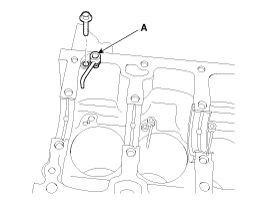
Check fit between piston and piston pin.
Try to move the piston back and forth on the piston pin.
If any movement is felt, replace the piston and pin as a set.
Remove the piston rings.
Using a piston ring expender, remove the 2 compression rings.
Remove the 2 side rails and oil ring by hand.
Arrange the piston rings in the correct order only.
Remove the connecting rod from the piston.
Using a press, remove the piston pin from piston.
Check the end play between piston and connecting rod.
End play
Standard : 0.05 ~ 0.302mm (0.0020 ~ 0.0119in)
If out-of-tolerance, install a new connecting rod.
If still out-of-tolerance, replace the crankshaft.
Check the connecting rod bearing oil clearance.
Check the match marks on the connecting rod and cap are aligned to ensure correct reassembly.
Remove the 2 connecting rod cap bolts.
Remove the connecting rod cap and lower bearing.
Clean the crankshaft pin journal and bearing.
Place a plastigage across the crankshaft pin journal.
Reinstall the lower bearing and cap, and tighten the nuts.
Tightening torque :
12.7Nm (1.3kgf.m, 9.4lb-ft) + (87~93°)
Do not turn the crankshaft.
Do not reuse the connection rod cap bolts.
Remove the 2bolts, connecting rod cap and lower bearing .
Measure the plastigage at its widest point.
Standard oil clearance
0.025 ~ 0.043mm (0.0010 ~ 0.0017in)
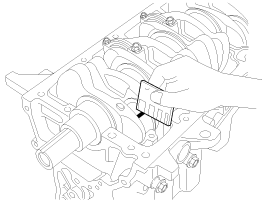
If the plastigage measures too wide or too narrow, remove the upper and lower bearing and then install a new bearings with the same color mark.
Recheck the oil clearance.
Do not file, shim, of scrape the bearings or the caps to adjust clearance.
If the plastigage shows the clearance is still incorrect, try the next larger or smaller bearing.
Recheck the oil clearance.
If the proper clearance cannot be obtained by using the appropriate larger or smaller bearings, replace the crankshaft and start over.
If the marks are indecipherable because of an accumulation of dirt and dust, do not scrub them with a wire brush or scraper. Clean them only with solvent or detergent.
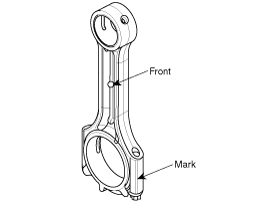
Mark | Connecting rod big-end inner diameter |
A | 49.000 ~ 49.006mm (1.9291 ~ 1.9294in) |
B | 49.006 ~ 49.012mm (1.9294 ~ 1.9296in) |
C | 49.012 ~ 49.018mm (1.9296 ~ 1.9298in) |
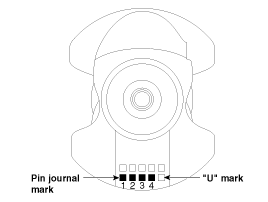
Mark | Crankshaft pin journal outer diameter |
A | 46.009 ~ 46.015mm (1.8114 ~ 1.8116in) |
B | 46.003 ~ 46.009mm (1.8111 ~ 1.8114in) |
C | 45.997 ~ 46.003mm (1.8109 ~ 1.8111in) |
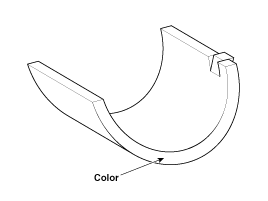
Color | Connecting rod bearing thickness |
Blue | 1.477 ~ 1.480mm (0.0581 ~ 0.0583in) |
Black | 1.480 ~ 1.483mm (0.0583 ~ 0.0584in) |
None | 1.483 ~ 1.486mm (0.0584 ~ 0.0585in) |
Green | 1.486 ~ 1.489mm (0.0585 ~ 0.0586in) |
Yellow | 1.489 ~ 1.492mm (0.0586 ~ 0.0587in) |
Select the bearing by using selection table.
Connecting rod bearing | Connecting rod mark | |||
A | B | C | ||
Crank shaft pin journal mark | A | Blue | Black | None |
B | Black | None | Green | |
C | None | Green | Yellow | |
Check the connecting rods.
When reinstalling, make sure that cylinder numbers put on the connecting rod and cap at disassembly match. When a new connecting rod is installed, make sure that the notches for holding the bearing in place are on the same side.
Replace the connecting rod if it is damaged on the thrust faces at either end. Also if step wear or a severely rough surface of the inside diameter of the small end is apparent, the rod must be replaced as well.
Using a connecting rod aligning tool, check the rod for bend and twist. If the measured value is close to the repair limit, correct the rod by a press. Any connecting rod that has been severely bent or distorted should be replaced.
Allowable bend of connecting rod :
0.05mm / 100mm (0.0020in / 3.94in ) or less
Allowable twist of connecting rod :
0.1mm / 100mm (0.0039in / 3.94in) or less
Check the crankshaft bearing oil clearance.
To check main bearing-to-journal oil clearance, remove the bed plate and lower bearings.
Clean each main journal and lower bearing with a clean shop towel.
Place one strip of plastigage across each main journal.
Reinstall the lower bearings and bed plate, then tighten the bolts.
Tightening torque :
Long bolts : 22.6~26.5Nm (2.3~2.7kgf.m, 16.6~19.5lb-ft) + 90~94°
Short bolts :
32.4~36.3N.m (3.3~3.7kgf.m, 23.9~26.8lb-ft)
Do not turn the crankshaft.
Remove the bed plate and lower bearing again, and measure the widest part of the plastigage.
Standard oil clearance :
0.024 ~ 0.042mm (0.0009 ~ 0.0017in)
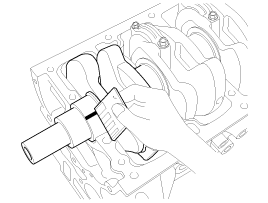
If the plastigage measures too wide or too narrow, remove the upper and lower bearing and then install a new bearings with the same color mark.
Recheck the oil clearance.
Do not file, shim, or scrape the bearings or the cap to adjust clearance.
If the plastigage shows the clearance is still incorrect, try the next larger or smaller bearing.
Recheck the oil clearance.
If the proper clearance cannot be obtained by using the appropriate larger or smaller bearings, replace the crankshaft and start over.
If the marks are indecipherable because of an accumulation of dirt and dust, do not scrub them with a wire brush or scraper. Clean them only with solvent or detergent.
Cylinder Block Crankshaft Journal Bore Mark Location
Letters have been stamped on the front face of block as a mark for the size of each of the 5 main journal bores.
Use them, and the numbers or letters stamped on the crank (marks for main journal size), to choose the correct bearings.
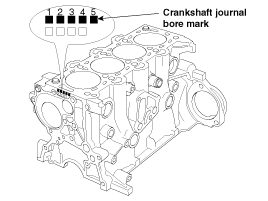
Mark | Cylinder block crankshaft journal bore inner diameter |
A | 58.000 ~ 58.006mm (2.2835 ~ 2.2837in) |
B | 58.006 ~ 58.012mm (2.2837 ~ 2.2839in) |
C | 58.012 ~ 58.018mm (2.2839 ~ 2.2842in) |
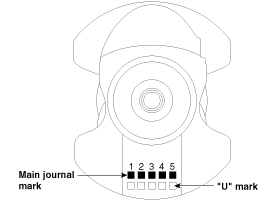
Mark | Crankshaft main journal outer diameter |
A | 53.984 ~ 53.990mm (2.1254 ~ 2.1256in) |
B | 53.978 ~ 53.984mm (2.1251 ~ 2.1254in) |
C | 53.972 ~ 53.978mm (2.1249 ~ 2.1251in) |
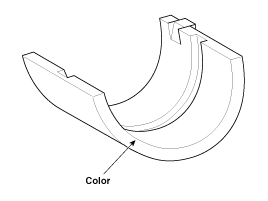
Color | Crankshaft main bearing thickness |
Blue | 1.990 ~ 1.993mm (0.0783 ~ 0.0785in) |
Black | 1.993 ~ 1.996mm (0.0785 ~ 0.0786in) |
None | 1.996 ~ 1.999mm (0.0786 ~ 0.0787in) |
Green | 1.999 ~ 2.002mm (0.0787 ~ 0.0788in) |
Yellow | 2.002 ~ 2.005mm (0.0788 ~ 0.0789in) |
Select the bearing by using selection table.
Crankshaft main bearing | Cylinder block crankshaft journal bore mark | |||
A | B | C | ||
Crank shaft main journal mark | A | Blue | Black | None |
B | Black | None | Green | |
C | None | Green | Yelllow | |
Check the crankshaft end play.
Using a dial indicator, measure the thrust clearance while prying the crankshaft back and forth with a screwdriver.
End play
Standard : 0.08 ~ 0.28mm (0.0031 ~ 0.110in)
Limit : 0.30mm (0.0118in)
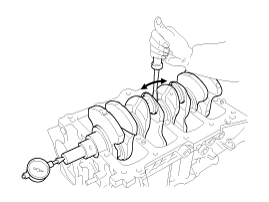
If the end play is greater than specification, replace the center main bearings as a set.
Thrust washer thickness of center main beaing :
2.335 ~ 2.385mm (0.0919 ~ 0.0939in)
Inspect the crankshaft main journals and pin journals.
Using a micrometer, measure the diameter of each main journal and pin journal.
Main journal diameter :
53.972 ~ 53.990mm (2.1249 ~ 2.1256in)
Pin journal diameter :
45.997 ~ 46.015mm (1.8109 ~ 1.8116in)
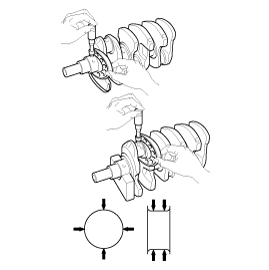
Remove the gasket material.
Using a gasket scraper, remove all the gasket material from the top surface of the cylinder block.
Clean the cylinder block
Using a soft brush and solvent, thoroughly clean the cylinder block.
Inspect the top surface of cylinder block for flatness.
Using a precision straight edge and feeler gauge, measure the surface contacting the cylinder head gasket for warpage.
Flatness of cylinder block gasket surface
Less than 0.05mm (0.0020in)
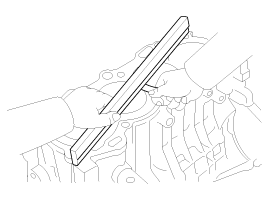
Inspect the cylinder bore.
Visually check the cylinder for vertical scratchs.
If deep scratchs are present, replace the cylinder block.
Inspect the cylinder bore diameter.
Using a cylinder bore gauge, measure the cylinder bore diameter at position in the thrust and axial direction.
Standard diameter :
1.4 [D4FC] :
75.000 ~ 75.030mm (2.9527 ~ 2.9539in)
1.6 [D4FB] :
77.200 ~ 77.230mm (3.0394 ~ 3.0405in)
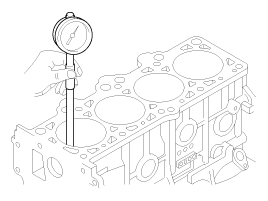
Check the cylinder bore size code on the cylinder block front face.
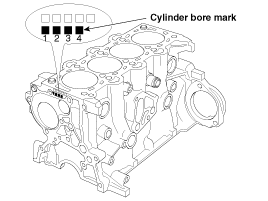
Mark | Cylinder bore inner diameter | |
1.4 [D4FC] | 1.6 [D4FB] | |
A | 75.000 ~ 75.010mm (2.9527 ~ 2.9531in) | 77.200 ~ 77.210mm (3.0394 ~ 3.0398in) |
B | 75.010 ~ 75.020mm (2.9531 ~ 2.9535in) | 77.210 ~ 77.220mm (3.0398 ~ 3.0402in) |
C | 75.020 ~ 75.030mm (2.9535 ~ 2.9539in) | 77.220 ~ 77.230mm (3.0402 ~ 3.0405in) |
Check the piston size mark (A) on the piston top face.
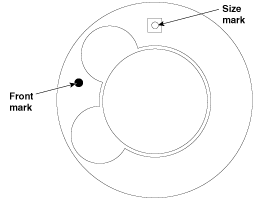
Mark | Piston outer diameter | |
1.4 [D4FC] | 1.6 [D4FB] | |
A | 74.930 ~ 74.940mm (2.9500 ~ 2.9503in) | 77.130 ~ 77.140mm (3.0366 ~ 3.0370in) |
B | 74.940 ~ 74.950mm (2.9503 ~ 2.9507in) | 77.140 ~ 77.150mm (3.0370 ~ 3.0374in) |
C | 74.950 ~ 74.960mm (2.9507 ~ 2.9511in) | 77.150 ~ 77.160mm (3.0374 ~ 3.0378in) |
Select the piston related to cylinder bore class.
Piston-to-cylinder clearance :
0.060 ~ 0.080mm (0.0024 ~ 0.0031in)
Oversize pistons should be selected according to the largest bore cylinder.
The size of piston is stamped on top of the piston.
Measure the outside diameter of the piston to be used.
According to the measured O.D(Outer Diameter), calculate the new bore size.
New bore size = piston O.D + 0.060 to 0.080mm (0.0024 to 0.0031in) (clearance between piston and cylinder) - 0.01mm (0.0004in) (honing margin.)
Bore each of the cylinders to the calculated size.
To prevent distortion that may result from temperature rise during honing, bore the cylinder holes in the firing order.
Hone the cylinders, finishing them to the proper dimension (piston outside diameter + gap with cylinder).
Check the clearance between the piston and cylinder.
Standard : 0.060 ~ 0.080mm (0.0024 ~ 0.0031in)
When boring the cylinders, finish all of the cylinders to the same oversize. Do not bore only one cylinder to the oversize.
Clean the piston.
Using a gasket scraper, remove the carbon from the piston top.
Using a groove cleaning tool or broken ring, clean the piston ring grooves.
Using solvent and a brush, thoroughly clean the piston.
Do not use a wire brush.
The standard measurement of the piston outside diameter is taken 10mm (0.39in) from bottom land of the piston.
Standard diameter :
1.4 [D4FC] : 75.000 ~ 75.030mm (2.9527 ~ 2.9539in)
1.6 [D4FB] : 77.130 ~ 77.160mm (3.0366 ~ 3.0377in)

Calculate the difference between the cylinder bore inner diameter and the piston outer diameter.
Piston-to-cylinder clearance :
0.06 ~ 0.08mm (0.0024 ~ 0.0031in)
Inspect the piston ring side clearance.
Using a feeler gauge, measure the clearance between new piston ring and the wall of ring groove.
Piston ring side clearance
No.1 : 0.09 ~ 0.13mm (0.0035 ~ 0.0051in)
No.2 : 0.08 ~ 0.12mm (0.0031 ~ 0.0047in)
Oil ring : 0.03 ~ 0.07mm (0.0012 ~ 0.0028in)
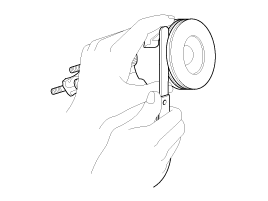
If the clearance is greater than maximum, replace the piston.
Inspect the piston ring end gap.
To measure the piston ring end gap, insert a piston ring into the cylinder bore. Position the ring at right angles to the cylinder wall by gently pressing it down with a piston. Measure the gap with a feeler gauge. If the gap exceeds the service limit, replace the piston rings. If the gap is too large, recheck the cylinder bore inner diameter. If the bore is over the service limit, the cylinder block must be rebored.
Piston ring end gap
No.1 : 0.20 ~ 0.35mm (0.0079 ~ 0.0138in)
No.2 : 0.35 ~ 0.50mm (0.0138 ~ 0.0197in)
Oil ring : 0.20 ~ 0.40mm(0.0079 ~ 0.0157in)
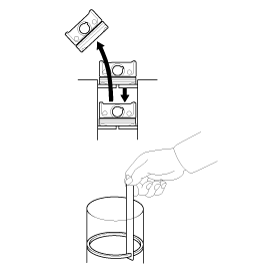
Measure the outer diameter of piston pin.
Piston pin diameter :
27.995 ~ 28.000mm (1.1022 ~ 1.1024in)

Measure the piston pin-to-piston clearance.
Piston pin-to-piston clearance :
0.004 ~ 0.015mm (0.0002 ~ 0.0006in)
Check the difference between the piston pin outer diameter and the connecting rod small end inner diameter.
Piston pin-to-connecting rod interference :
0.022 ~ 0.039mm (0.0009 ~ 0.0015in)
Thoroughly clean all parts to assembled.
Before installing the parts, apply fresh engine oil to all sliding and rotating surfaces.
Replace all gaskets, O-rings and oil seals with new parts.
Assemble the piston and connecting rod.
Use a hydraulic press for installation.
The piston front mark and the connecting rod front mark must face the timing belt side of the engine.

Install the piston rings.
Install the oil ring expander and 2 side rails by hand.
Using a piston ring expander, install the 2 compression rings with the code mark facing upward.
Position the piston rings so that the ring ends are as shown.
Install the connecting rod bearings.
Align the bearing claw with the groove of the connecting rod or connecting rod cap.
Install the bearings (A) in the connecting rod and connecting rod cap (B).
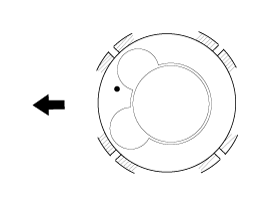
Install the crankshaft main bearings.
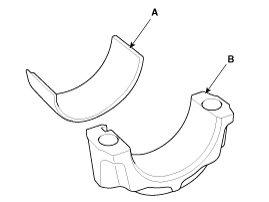
Upper 1, 2, 4, 5 bearings have an oil groove of oil holes ; Lower bearings do not.
Align the bearing claw with the claw groove of the cylinder block, push in the 5 upper bearings (A).
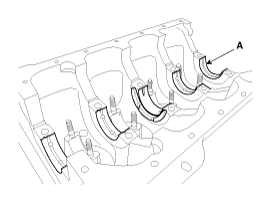
Align the bearing claw with the claw groove of the main bearing cap, and push in the 5 lower bearings.
Install the oil jet (A).
Tightening torque :
8.8 ~ 12.7N.m (0.9 ~ 1.3kgf.m, 6.5 ~ 9.4lb-ft)

Place the crankshaft on the cylinder block (A).

Place the bed plate on the cylinder block (A).

Standard liquid gasket : FD20, HYLOMAR3000, Dreibond 5105
Check that the mating surfaces are clean and dry before applying liquid gasket.
Apply liquid gasket in a 3mm wide bead without stopping.
After assembly, wait at least 30 minutes before filling the engine with oil.
Install the bed plate bolts.
The bed plate bolts are tightened in 2 progressive steps.
If any of the bed plate bolts in broken or deformed, replace it.
Apply a light coat of engine oil on the threads and under the bed plate bolts.
Tighten the bolts (11, 17, 20) in numerical order.
Tighten the main bearing cap bolts (1~10) in numerical order using the SST (09221-4A000).
Loosen the bolts (11, 17, 20).
Tighten the bolts (11~20) in numerical order.
Tighten torque of main bearing cap bolts.
Tightening torque
Long bolts(1~10) :
22.6~26.5Nm (2.3~2.7kgf.m, 16.6~19.5lb-ft) + 90~94°
Short bolts(11~20) :
32.4~36.3N.m (3.3~3.7kgf.m, 23.9~26.8lb-ft)
Always use new main bearing cap bolts.
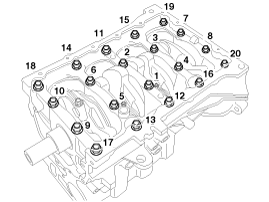
Check that the crankshaft turns smoothly.
Check the crankshaft end play.
Install the piston and connecting rod assemblies.
Before installing the piston, apply a coat of engine oil to the ring grooves and cylinder bores.
Remove the connecting rod caps (A), and slip short sections of rubber hose over the threaded ends of the connecting rod bolts.
Install the ring compressor, check that the rings are securely in place, then position the piston in the cylinder, and tap it in using the wooden handle of a hammer.
Stop after the ring compressor pops free, and check the connecting rod-to-crank journal alignment before pushing the piston into place.
Apply engine oil to the bolt threads. Install the rod caps with bearings, and tighten the bolts using the SST (09221-4A000).
Tightening torque :
12.7Nm (1.3kgf.m, 9.4lb-ft) + (87~93°)

Always use new connecting rod bearing cap bolts.
Maintain downward force on the ring compressor to prevent the rings from expending before entering the cylinder bore.

Install the water pipe.
(Refer to Cooling System – “Water Pipe”)
Install the cylinder head.
(Refer to Cylinder Head Assembly - "Cylinder Head")
Install the exhaust manifold.
(Refer to Intake And Exhaust System - "Exhaust Manifold")
Install the intake manifold.
(Refer to Intake And Exhaust System - "Intake Manifold")
Install the timing chain.
(Refer to Timing System – “Timing Chain”)
Remove the engine stand.
Install the rear oil seal.
(Refer to Cylinder Block – “Rear Oil Seal”)
Automatic transaxle : Install the drive plate.
(Refer to Cylinder Block – “Drive Plate”)
Manual transaxle : Install the flywheel.
(Refer to Cylinder Block – “Flywheel”)